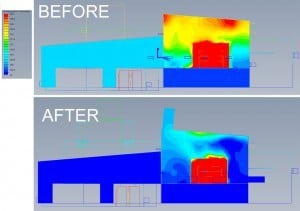CFD Modeling for Industrial Ventilation
Moffitt Corporation has been designing industrial ventilation systems with a paper & pencil for over 50 years. Of course, the technology has changed significantly in the last five decades. Now, in addition to paper & pencil, we use sophisticated CFD modeling to design the most effective and efficient ventilation systems.
Advanced CFD Modeling for High Heat Facilities

For complex facilities that need a certain level of airflow at specific locations, our team utilizes innovative CFD modeling. Computational Fluid Dynamics modeling (CFD) allows us to envision your building’s airflow and heat transfers before and after ventilation improvements have been made. By analyzing heat movement throughout your building, we can create the perfect ventilation system. This allows us to compare ventilation options.
Cutting-edge design programs like CFDesign, AutoCAD, and SolidWorks are used to create these intricate simulations. By creating a complete model of your building, including all its doors, windows, vents, and fans, we can analyze the interaction of heat and air throughout the building. Introducing new elements into these models shows us how your building’s temperature will change within the building. Adding vents and fans will change the airflow.
CFD modeling is often used for aeronautic and aerodynamic design, but it is also popular with building designers and engineers. This technology utilizes air flow tracking show air-movement across the work floor and around machinery. This software is also can show the airflow curvature around a jet or a car. The system utilizes It allows a designer to see the impact each curve, corner, inlet, and outlet has on the airflow. Whether it’s on a car or within the building complete complex thermodynamic analysis changes the way we look at air movement.
Computerized Air Flow Modeling
Heavy industrial facilities that produce a lot of heat, like Foundries, Forges, Smelters, and Power Plants, find these computer models extremely useful. Other industries like chemical plants, paper mills, data centers, and refineries are seeing the benefits of computer modeling in their ventilation systems too. Managers and owners like to see how a ventilation upgrades can benefit their facility before investing money into large capital improvements. Computer air-flow modeling allows us to do just that.
Our design engineers will improve airflow, lower temperatures at certain elevations throughout the building. They will also consider special conditions such as closed bay doors. Furthermore, they can even adjust for seasonal temperature changes and show you what conditions look like in the middle of summer. These options will let you better choose the right system for your needs and budget based.
There is no room for mistakes when it comes to building ventilation. You don’t want to discover that the new ventilation system does not effectively evacuate the stifling air. Or that the new system has created hot spots on your work floor. You need be sure that they will get the most effective and efficient ventilation system possible.
Modeling & air-flow simulation technologies allow us to take guesswork out of the process. Instead of just telling you your building will be “cooler” by x number of degrees, we can provide a complete temperature gradient of airflow throughout the building. By seeing clear, full-color models that show dependable and accurate results, you can rest assured that you’re getting the right ventilation solution for your facility. CFD modeling can save you from a headache of not knowing which ventilation system to choose.
Key Benefits of CFD Modeling for Industrial Ventilation.
- Provides data on air-flow changes within the model.
- Illustrates temperature changes throughout the building.
- Accurately predicts the performance of proposed ventilation design.
- Compares system options (i.e. Natural Ventilation systems v. Powered System) for better-informed decision making.
- Can adjust for seasonal temperature and weather changes.
- Offers dependable and proven results.
Contact your local Moffitt representative today to learn more about building ventilation & computer air-flow modeling and analysis.

